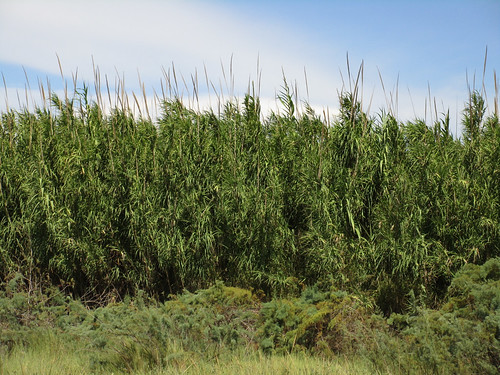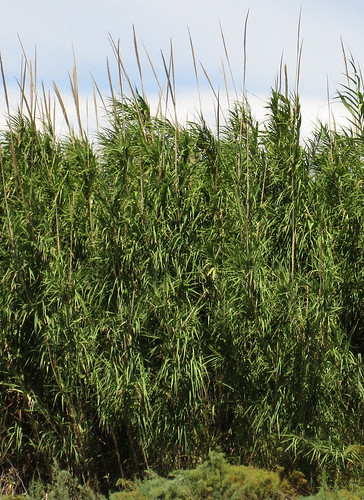Abundance: plentiful
What: roots, leaves, young shoots
How: roots raw, cooked, ground into flour; leaves boiled; young shoots raw or cooked
Where: sunny wet ditches, moist areas
When: spring, summer
Nutritional Value: calories, minerals
Dangers: contains small amount of alkaloid gramine which is more toxic to dogs than to humans
Stand of Giant Reeds. These are over seven feet tall.

Slightly closer view of Giant Reeds.

Giant reeds in later spring. The green ones are this-years growth.

Young giant reed shoot.

Texas distribution, attributed to U. S. Department of Agriculture. The marked counties are guidelines only. Plants may appear in other counties, especially if used in landscaping.

North American distribution, attributed to U. S. Department of Agriculture.

Giant reeds look very similar to bamboo, especially towards the base. The reed is hollow like bamboo and structurally can be used in many of the same ways as bamboo though it does not have the full load-bearing strength of bamboo. Giant reeds are considered to be invasive plants and can quickly swallow any location where they get enough sun and moisture.
The roots (rhizomes) are the main edible portion of giant reeds. They contain some calories in the form of starch and even sugars, especially when still young and tender. As the roots age they become fibrous/woody. The young roots can be eaten raw, boiled, steamed, or baked. They can also be dried then ground into flour.
The leaves are edible though quite bitter. Their flavor can be mellowed by boiling. A change of water during boiling usually isn't necessary except with the most bitter of leaves.
The young shoots, when available, are used like bamboo shoots and/or asparagus.
Buy my book! Outdoor Adventure Guides Foraging covers 70 of North America's tastiest and easy to find wild edibles shown with the same big pictures as here on the Foraging Texas website.

